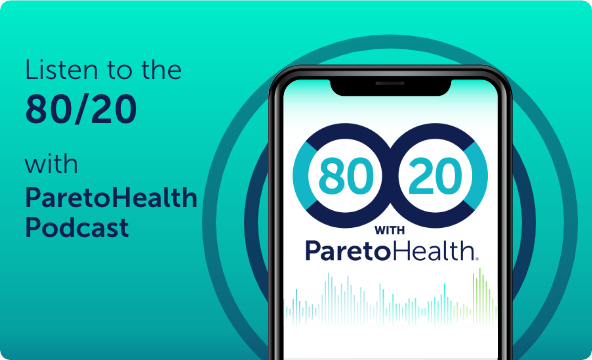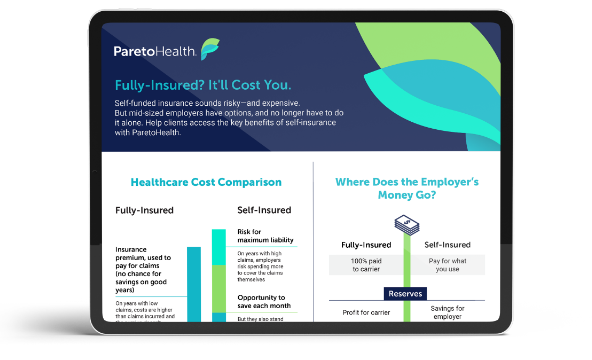What is a group captive?
We get it: Navigating the American healthcare system is tough.
If you’ve landed here, you’re probably struggling with your employee benefits. You’ve likely heard of an insurance captive (at least in passing) and wonder if it’s a good funding option for your company.
A growing number of midsized employers like you are taking this approach to combat the rising cost of healthcare. So, let’s dig a little deeper into what this really means.
Defining the captive
A captive is an insurer owned by the people or entities using its services. Think about it like a credit union. When opening a policy, you become a stakeholder there, with the amount of your stake equaling the amount of money in your account.
In other types of plans (most notably, fully-insured), it’s a different story. Here, it’s like having an account at a bank. You’re simply using a service they provide.
A group captive is an insurance captive that serves more than one person or entity. There are as many types of group captives as there are types of insurance: property & casualty, homeowner’s insurance, and so on.
Employee benefits captives
Employers across the United States are increasingly interested in employee benefits group captives. This is due to the changing healthcare marketplace and to a philosophical shift in their mindset. Because of the opaque and expensive traditional offerings, they want to take control of their healthcare spend without compromising on quality.
The cost of employee health insurance is high and often rises unpredictably. Many midsized businesses are being squeezed dry, and they usually do not know how much their employee benefits costs will increase next year. Since this item is usually the second or third largest (behind payroll) in the operations budget, employers are seeking ways to decrease the cost and volatility of their health benefits.
The incidence of high-cost claims has risen dramatically in the past decade, and the trend is only set to continue. New gene therapies (for instance), while promising for the treatment of severe medical conditions, often come with multi-million-dollar costs. One such case, while rare, could lead to catastrophic increases in healthcare spending.

That’s why many employers have come together to combat these rising costs. By creating or joining captives to buy coverage for their employees, gaining superior terms on reinsurance, and spreading volatility out over the entire population, these employers are getting better plan terms and better benefits.
How does this happen?
First, we need to consider the size and scale of a group captive.
Let’s say you’re buying a stop-loss policy worth $400,000 for a business with 150 employees. You’d have to deal with a few of the following realities:
- Your future policies are wholly dependent on your claims experience.
- You can’t rely on a statistically normal distribution of catastrophic claims.
- You have no guarantees that your stop-loss policy will continue to cover the people who need it the most and shield your business from risk.
What does this mean?
If one of your 150 employees had a multi-year or catastrophic health claim that cost your plan millions of dollars, you might face a laser or a massive renewal increase for the policy. This is because, for your carrier, the policy represents $400,000 in their book of business, but it may have cost them several million in claims. No entity can last long if the economics add up like that.
However, when you’re in a group captive with thousands of other employers representing hundreds of thousands of employees, a catastrophic claim from one employee is a ripple in the ocean. By spreading these costs across the owners and users of the captive, you reduce volatility as you work to support each other.
In addition, larger populations tend to follow a statistically normal distribution of unusual events more than smaller ones do.
Think about it like this: You have a group of five people, and you want to find their average height. One particularly tall or short person can easily skew the result and make it seem like that group, on average, is very tall or very short. If you include the same very tall or very short person in a group of several hundred, their impact on the average is significantly reduced. Expand the group to many thousands, and they may have no individual effect.
At ParetoHealth, we refer to this as “the ocean effect.” If you take a 55-gallon drum of salt and drop it into a bathtub, the salinity of the water will change drastically. Drop it into the ocean, and the effect will be unmeasurable. The salt represents high claims, and the water represents the population you are dealing with. Get a large enough body of water, and you can absorb the volatility.
The ParetoHealth difference
ParetoHealth’s mission is to reduce the impact of volatility on individual employers, make self-insurance possible for small and midsize businesses, and help reduce the overall cost of healthcare.
Our employee benefits captive program makes that happen. We provide a 30% rate cap on your stop loss policy and no new lasers, ever, as long as you’re part of our program – making our stop loss policies unique.
Your stop loss premium is a much smaller proportion of your total plan costs than a fully-insured premium: a 30% increase in this premium is usually equivalent to about 7-8% fully-insured.
There is a certain amount of risk-sharing here. Still, your captive manager is responsible for accepting prospective members who are financially healthy and represent a match for our overall risk pool. We believe in helping employers combat volatility and rising costs, and the employers in our program reflect that.
A fully-insured program includes the same or higher risk-sharing with other customers of that carrier, but there’s a big difference: Fully-insured carriers can easily hand out premium increases, and their processes can be opaque and dependent on many different factors.
Simply put, you can think of it this way: traditional insurance carriers often drive value to shareholders through higher premiums that increase profit margins. Our approach drives value to employers by reducing healthcare spending and the volatility that employers have to face.
If you’re interested in fighting the rising tide of healthcare costs, reducing volatility, and gaining true ownership over your employee benefits, ParetoHealth is here to get you started.
There’s a Better Way to Do Employee Health Benefits
Join an upcoming webinar to learn how ParetoHealth turnkey employee health benefits solutions deliver the scale and resources mid-sized businesses need to self-insure with total confidence. By combining a captive model with comprehensive medical and pharmacy cost containment strategies, our members realize significant cost savings with multi-year protection.
 December 6, 2023
December 6, 2023 






